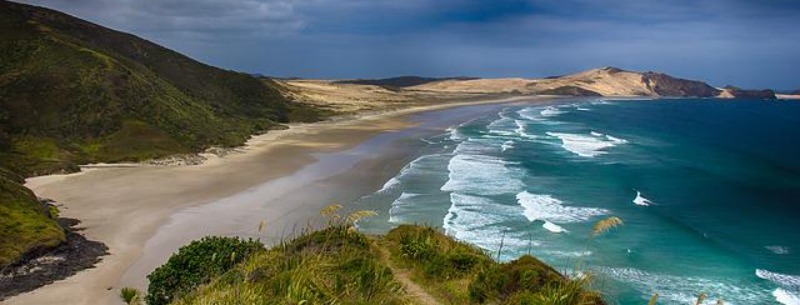New Zealand is an adventurer’s delight, from the native kauri forests and white sandy bays of the North Island to the majestic fiords and alps of the South Island. A volcanic, mountainous land, it is made up of two large islands, the ‘North’ and ‘South,’ and Stewart Island tucked away deep in the South Pacific. An unspoiled paradise of fabulous contrasts, New Zealand is the only holiday destination where you can walk on an active volcano, surrounded by hissing fumaroles and spitting mud pools; stroll through ice caves past huge fissures on a glacier, fish at the ‘trout factories’ as the lakes and rivers are commonly called and go black-water rafting through underground caves riddled with glow worms.
Capital And Major Centers
Auckland, known as the City of Sails, is the hub of the North Island and the largest city in New Zealand with more than one million residents. It’s a busy cosmopolitan metropolis built on either side of a sparkling harbor and is the largest Polynesian city in the world. The city offers plenty of shopping, dining, sightseeing, and sailing. It’s also the gateway to the tourist centers of the Coromandel, Rotorua, and Lake Taupo to the south and the Bay of Islands to the north.
Wellington, the capital, is located on the southern tip of the North Island and is a picturesque city built on hills, circling a spectacular harbor lined with fashionable wharf restaurants and bars. Old-style buildings comfortably rub shoulders with modern architecture such as the beehive-shaped parliament house.
Christchurch on the South Island has beautiful old solid buildings, wide thoroughfares, lots of pavement dining, and people-watching opportunities on sunny days. Located on the Avon River, it has a decidedly English atmosphere. You can wander through the bountiful botanical gardens, dine in the Gothic surroundings of the former Christchurch University, or climb Port Hills for a view of the Southern Alps and the turquoise waters of Lyttelton Harbour.
Dunedin, because of its Scottish heritage, has many fine old stone buildings and a statue of the famous poet Robbie Burns in the center of town.
New Zealand has three international airports – Auckland, Wellington, and Christchurch.
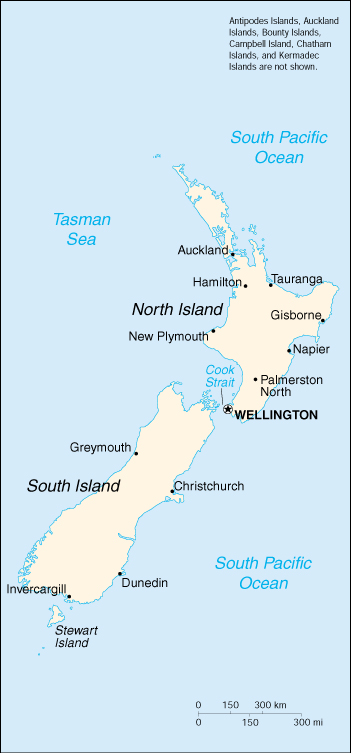
People
Of the 3.9 million population, there are approximately 280,000 Maoris of Polynesian origin. However, the majority of the population is of European descent. English and Maori are the official languages.
New Zealand History
The Maoris have lived in New Zealand for more than one thousand years. It is believed that they came in migratory ways from the Pacific Islands. The Treaty of Waitangi was signed in 1840 by Maori chiefs and representatives of the British crown, making the country a British colony. Today New Zealand is self-governing.
Nature
In the Bay of Islands, you can find what many fishermen believe are the largest specimens of striped marlin in the world. You can also go on tours which promise you a swim with schools of dolphins or a leisurely sail around the many tiny islands in the tall ship.
In Northland, Kauri forests are some of the few remaining stands of giant native kauri trees. The biggest is Tane Mahuta (Lord of the Forest), which stands nearly 52 meters tall and is over 200 years old.
The Mount Bruce National Wildlife Centre near Masterton has rare and endangered birds and other species, including the kiwi, New Zealand’s unofficial national symbol. Giant wetas, one of the world’s heaviest insects, native bats, and the takahe, a bird thought to be extinct until it was rediscovered in the 1950s.
New Zealand Attractions
In Auckland, there are parks, rose gardens, and wildlife sanctuaries alongside all the attractions of a big city while away many pleasant hours, or you can make a day trip to one of the beautiful relaxed inner islands of the Hauraki Golf accessible by ferries and catamarans.
Rotorua is a famous thermal city and resort. There are safe walkways through the main thermal areas, bathing grottos to sit in of varying temperatures, and you can visit Mount Tarawera, which erupted in 1886 and now has a massive crater.
Lake Taupo, framed by snowcapped peaks, is a resort of breathtaking beauty, renowned for its rainbow trout fishing. There are lots of water sports and boats for hire, and a bustling tourist-friendly town offers a range of tours and comfortable accommodations.
Queenstown, at the foot of the Remarkables Range, is where you can get a jet boat ride, go white water rafting, or try tandem parachuting. This town is also the capital of bungy jumping and a very popular ski resort in winter.
New Zealand Lodging
Accommodation in New Zealand is many and varied, ranging from international standard hotels and exclusive private lodges to motels, hostels, homestays, farm stay, camping grounds, and cabins.
Getting Around
Touring is easy with the option of hire cars and motor homes for self-drive options and tour buses. There are also guided tours or regularly scheduled bus, train, and ferry services in and between main towns with discounted passes available or combined travel.
Food And Entertainment
New Zealand is a major producer of lamb, venison, and beef, with fruit and vegetables in abundance. The seas yield a variety of fish, rock lobsters, oysters, and scallops. There are excellent restaurants that offer a wide range of international cuisine, including Polynesian-influenced foods. Attending a traditional hangi (Maori feast cooked in-ground) is a special treat. Cafes, bars, discos, and nightlife can be found in all the major cities and larger towns.
New Zealand Activities
Activities include fishing, golfing, windsurfing, sailing, water skiing, snow skiing, hunting, and snowboarding. Indeed, climbers and hikers come from all parts of the world to enjoy the unlimited scope for recreation in the magnificent unspoiled wilderness areas and national parks. For the more adventurous, there are scenic flights, luge riding, tandem parachuting, white and black water rafting, jet boating, horse riding, and 4WD volcanic safaris.
Shopping Guide
Many imports carry very little or no tariff, so goods are cheaper here than in other countries. Sheepskins, abalone shells, and New Zealand jade are popular local purchases. Traditional crafts such as pottery, glass blowing, hand knitting, and carving are made within both the European and Maori cultures, and communes of craftspeople sell their wares at local stalls and craft shops. Look for traditional Maori carving in wood, bone, and greenstone and jewelry made from abalone shells, bone, ceramics, silver, and greenstone.
New Zealand Facts At A Glance
| CLIMATE | North – sub-tropical with temperate winters. South – winter snows and temperate summer months. |
|---|---|
| CLOTHING | Casual even in the best hotels and nightclubs. |
| ELECTRICITY | 230 volts, 50 hertz. 110 volts are available in most hotels and motels. |
| TIME ZONE | AEST plus 2 hours. Daylight saving from October to late March. |
| TIPPING | Optional. |
| CURRENCY | New Zealand dollars. Credit cards are widely accepted. |
| VISAS AND HEALTH | Airport tax of NZ$20 from Auckland and Wellington and NZ$25 from Christchurch. No vaccination certificate is required. Visas may be needed by some countries. |
| GETTING THERE | Fifteen international airlines offer services to North America, Asia, Europe, and the Pacific Islands. Air New Zealand and Ansett Air New Zealand operate domestic flights. |
Dive New Zealand
Noted for its flightless kiwis and large numbers of sheep, New Zealand now shyly reveals a vast contrast of marine terrain to amaze the traveling diver.
The North Island is the recipient of a warm tropical south-flowing current that brings clear waters to the offshore Poor Knights Islands. Traveling on the current is a host of tropical juvenile fish that make the islands their home. The mix of temperature and tropical species makes the islands unique. Hence the establishment of a marine reserve that encompasses the entire area.
Huge sea caves and soaring arches are veiled with curtains of fish. Plummeting walls are visited by masses of trevally and kingfish who are, in turn, followed by oceanic sharks such as the swift Mako. From the shallow kelp forests to the deep sponge garden, Poor Knights offers a rich experience for any diver.
The eastern coast of the northern islands boasts many island groups such as the Hen and Chickens, Great Barrier Island, and the active volcanic White Island. All offer superb diving with clear offshore water, colorful sponge gardens, lobsters, and swarming fish life.
The North and South Islands are divided by Cook Strait, which, due to its unstable nature, contains many shipwrecks, including a huge Russian passenger liner. All can be safely dived on frequent charters utilizing the knowledge and expertise of local dive operators.
While the water can get chilly in the South Island, the marine life becomes quite spectacular. Kaikoura, on the east coast and north of Christchurch, has an abundance of marine mammals and fish life thanks to a deep drench that comes within one kilometer of the shore. Nutrients from the 800 to 1600-meter drench are forced to the surface, building a food chain to feed seals, schooling fish, diver-friendly dolphins in pods of up to 1500, Orcas, and the mighty sperm whale which are residents year-round.
On the southwest coast, deep fjords cut into the shoreline, forming sheer cliffs that plummet through still waters to unfathomed depths. Usually, a layer of tinted freshwater lies on the surface allowing massive blooms of black coral to thrive in relatively shallow water.
With its northern nose jutting into tropical currents and its southern toes dabbling in the sub-Antarctic Ocean, New Zealand spans a rich and diverse marine world waiting to amaze divers of all levels of experience.
North Island
The Bay of Islands is 240 kilometers from Auckland, a paradise of rolling hills and bays lapped by sea-green crystal waters. Visitors can enjoy an array of water-based activities including tall mast sailing, swimming with dolphins, sailing, windsurfing, and fishing.
The famous “Cream Trip” is a day cruise among the 140 islands in the area or you can take a speed boat tour to the famous hole-in-the-rock and neighboring inlets. The main center is Paihia with good accommodation and a selection of cruises, including big game fishing. Across the bay by ferry is the historic township of Russell, the first capital of New Zealand which is superbly restored and retains most of its 19th-century wooden buildings.
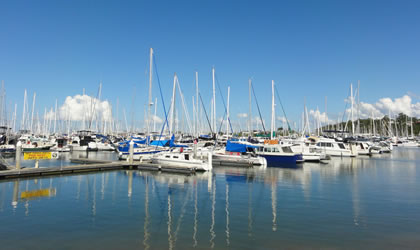
Close by is Waitangi where the Treaty of Waitangi was signed in Treaty House, home of the British Resident. The nearby Maori Meeting House has carvings representing many different tribes and a 437 meter, 150 man war canoe which is launched every Waitangi Day, (February 6th).
At the northernmost tip of the northern islands is Cape Reinga where a lone pohutukawa tree marks a sacred spot for Maoris. From here Ninety Mile Beach sweeps down the west coast to Kaitaia forming a spectacular beach bus trip back towards the Bay of Islands area.
Not far from Auckland is Hamilton the main center of the Waikato region. History is recaptured at the annual Maori War Canoe Regatta held at Ngaruawahia each March. Don’t miss cruising the Waikato River, the Waitomo glow worm caves, and the chance to black water raft in the nearby deep underground caves.
Other special spots are Rotorua, the thermal center, Coromandel’s small beaches, Gisborne’s Maori meeting houses, Cape Kidnapper’s gannet colony, and sparkling Lake Taupo. In the southern part of the North Island, a few miles north of Masterton is the Mount Bruce National Wild Life Centre, where rare and endangered birds are studied and bred. To the west near New Plymouth, you can Mount Taranaki, a volcanic cone surrounded by green dairy pastures.
South Island
You can get directly to the South Island via international flights or by flying from Auckland, Wellington, Christchurch or Dunedin. It is also possible to take a ferry from Wellington to Picton through the Marlborough Sounds.
This is an idyllic marine playground indented by secluded coves and pristine beaches. The sheltered waterways meander for more than 966 kilometers with many perfect spots only accessible by boat. You can take a tour by ferry into the many bays or hike on foot along the ridge of Queen Charlotte Sound. Marlborough has long hot summers and frosty clear winters, so it is the center of New Zealand’s great growing region. The annual wine festival is held each February. Some 130 kilometers south of the region’s main town, Blenheim is Kaikoura, famous for whale watching. You can take a boat tour and view at close range huge sperm whales frolicking in the warm waters.
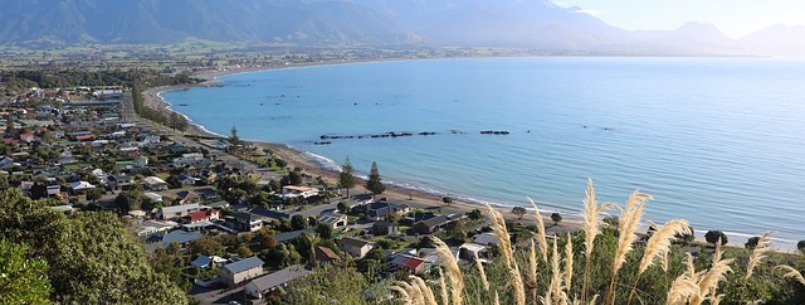
In contrast, the West Coast hemmed between the South Island’s Southern Alps and the Tasman Sea is wet, wild, and magnificent. A largely unspoiled area, it has four national parks comprising a world heritage site. Great hiking trails abound in this region. There are caves, gorges, blowholes, and spectacular glaciers.
Heading inland to Central Otago, you can visit the region of New Zealand’s Gold Rush of the 1860s. The hills and valleys still display evidence of this era where shacks, mines and machinery can still be seen along the Goldfields’ Heritage Highway which winds through quaint villages and past historic pubs.
Queenstown is an all-year round alpine resort where you can water ski, jet boat ride, white water raft, fish, horse ride, windsurf, play golf, hike, go gold panning or bungy jumping. In winter you can ski to your heart’s delight on Coronet Peak and the Remarkables, which are aptly named or it is one of the most beautiful mountain ranges in the world.
South to Lake Te Anau, the gateway to Fiordland National Park and the Te-Ana-au Glowworm caves is nature on a grand scale where waterfalls tumble thousands of feet into virgin forested valleys and fiords which indent the coast. Stewart Island across the strait from Invercargill, a ferry ride away, is the perfect place for those seeking peace and isolation in a superb bushland setting.
Kaikoura Canyon
The largest measured giant squid, stranded on a New Zealand beach in 1880, stretched nearly 60 feet from the tip of its mantle to the tips of its 40-foot tentacles. It was judged to weigh about a ton. Its eyes, the largest of any animal, were about the size of a person’s head. Experts believe that even larger squid still exist in the Kaikoura Canyon of the South Island of New Zealand.
A beast of legend since Aristotle’s time, the giant squid is the villain in Jules Verne’s 20,000 Leagues Under the Sea and the sea monster of sailors’ tales. What is not a legend, however, are the remains of about 200 animals trapped in nets or washed up on beaches around the world.
In 1997, three dead giant squids were found in New Zealand waters and the remains were kept at the National Institute of Water and Atmospheric Research in Wellington. The remains still possessed an aura of menace. The boneless torpedo-shaped body consisted of a mantle of muscular tissue surrounding translucent internal support called the gladius and evolutionary remnant of molluscan ancestors’ shells. The squid’s cylindrical head is attached to its body by a neck with a collar of muscle. Eight thick arms and two longer, thinner tentacles emerged from the head like a bizarre crown. Hundreds of suckers, each pivoting on its own base, cover the inside of the arms. At the end of the tentacles are “clubs” lined with four rows of saw-toothed suckers that look like round little mouths encircled by tiny pointed teeth.
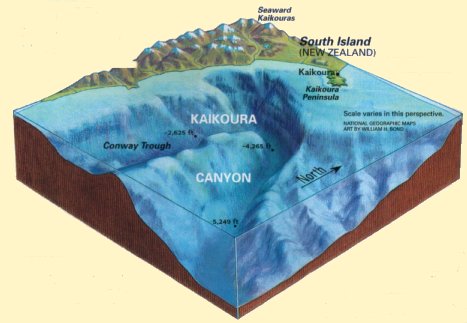
To eat, a squid shoots out its tentacles and grasps prey, closing the tentacles like a pair of pliers and coiling them back to a parrot-like beep that cuts the prey into bite-size chunks. A raspy tongue flips the chunks down the esophagus, which, on the way to the stomach, passes through the brain.
Kaikoura Peninsula points towards the deep waters of the Kaikoura Canyon. A Maori legend says that an apprentice wanting to please the Creator put underwater mountains here to frame Kaikoura Canyon.
Beyond the breakers lapping the South Island of New Zealand, the world drops off, creating a deepwater lair for the giant squid. Earthquakes send torrents of silt sluicing through the canyon, which lies at the head of a thousand-mile-long seafloor channel.
Scientists studying stranded sperm whales on a beach about 145 miles north of Kaikoura have found on every head, around the jaws, the signs of the giant squid in the form of arrays of round scars left by the saw-tooth suckers of the giant squid. A sperm whale eats about a ton of food a day, most of it squid. To find the giant squid, sperm whales must plunge into the depths of the Kaikoura Canyon. This could mean dives of 3,000 to 5,000 feet. Scientists are not sure if this is possible.
Even though the giant squid has not been sighted, electronic sensing equipment at a depth of 2,400 feet, has shown images of giant squid fighting with a three-foot shark. The evidence suggests that the giant squid exists in the Kaikoura Canyon. At the moment, this evidence is in the form of remains washed up on the beaches as well as electronic images of this elusive creature of the depths.
